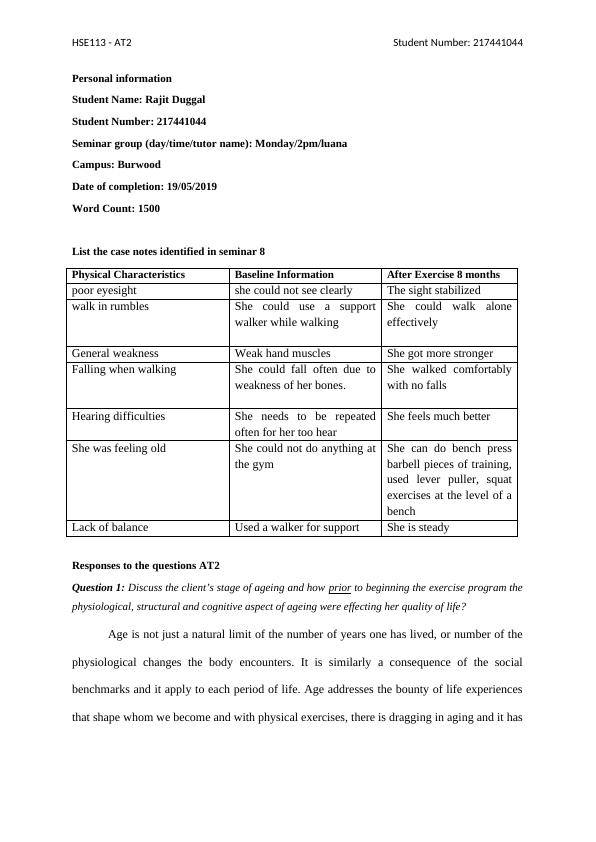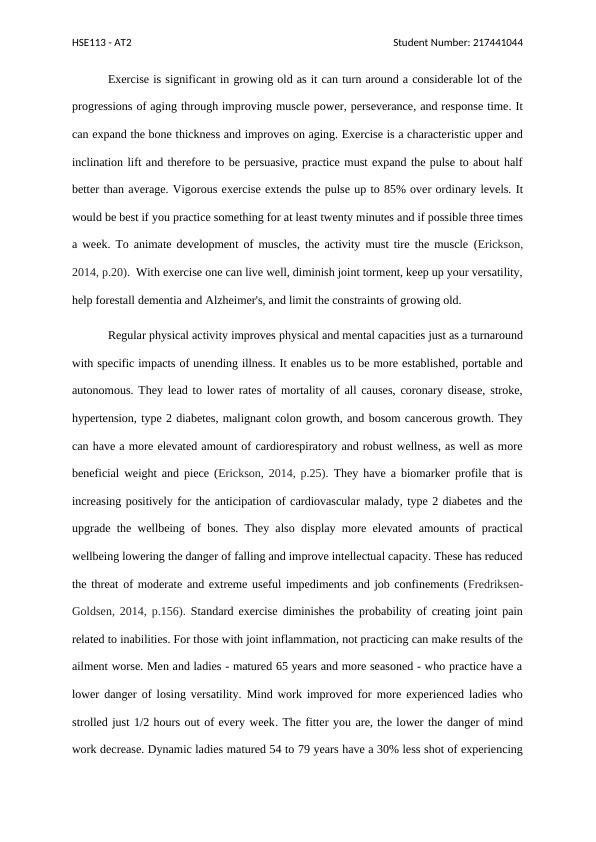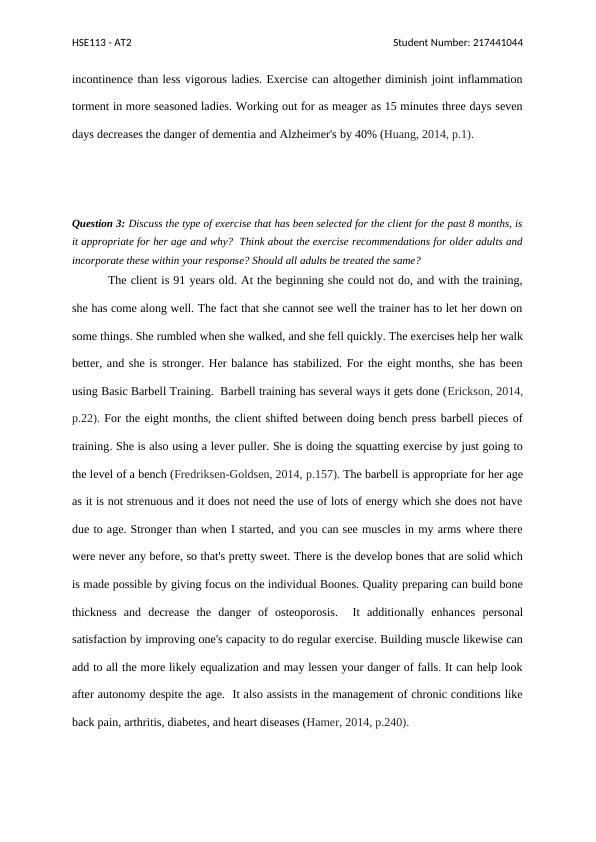Influence of Exercise on Ageing Process
Added on 2023-01-24
11 Pages3117 Words48 Views
HSE113 - AT2 Student Number: 217441044
Personal information
Student Name: Rajit Duggal
Student Number: 217441044
Seminar group (day/time/tutor name): Monday/2pm/luana
Campus: Burwood
Date of completion: 19/05/2019
Word Count: 1500
List the case notes identified in seminar 8
Physical Characteristics Baseline Information After Exercise 8 months
poor eyesight she could not see clearly The sight stabilized
walk in rumbles She could use a support
walker while walking
She could walk alone
effectively
General weakness Weak hand muscles She got more stronger
Falling when walking She could fall often due to
weakness of her bones.
She walked comfortably
with no falls
Hearing difficulties She needs to be repeated
often for her too hear
She feels much better
She was feeling old She could not do anything at
the gym
She can do bench press
barbell pieces of training,
used lever puller, squat
exercises at the level of a
bench
Lack of balance Used a walker for support She is steady
Responses to the questions AT2
Question 1: Discuss the client’s stage of ageing and how prior to beginning the exercise program the
physiological, structural and cognitive aspect of ageing were effecting her quality of life?
Age is not just a natural limit of the number of years one has lived, or number of the
physiological changes the body encounters. It is similarly a consequence of the social
benchmarks and it apply to each period of life. Age addresses the bounty of life experiences
that shape whom we become and with physical exercises, there is dragging in aging and it has
Personal information
Student Name: Rajit Duggal
Student Number: 217441044
Seminar group (day/time/tutor name): Monday/2pm/luana
Campus: Burwood
Date of completion: 19/05/2019
Word Count: 1500
List the case notes identified in seminar 8
Physical Characteristics Baseline Information After Exercise 8 months
poor eyesight she could not see clearly The sight stabilized
walk in rumbles She could use a support
walker while walking
She could walk alone
effectively
General weakness Weak hand muscles She got more stronger
Falling when walking She could fall often due to
weakness of her bones.
She walked comfortably
with no falls
Hearing difficulties She needs to be repeated
often for her too hear
She feels much better
She was feeling old She could not do anything at
the gym
She can do bench press
barbell pieces of training,
used lever puller, squat
exercises at the level of a
bench
Lack of balance Used a walker for support She is steady
Responses to the questions AT2
Question 1: Discuss the client’s stage of ageing and how prior to beginning the exercise program the
physiological, structural and cognitive aspect of ageing were effecting her quality of life?
Age is not just a natural limit of the number of years one has lived, or number of the
physiological changes the body encounters. It is similarly a consequence of the social
benchmarks and it apply to each period of life. Age addresses the bounty of life experiences
that shape whom we become and with physical exercises, there is dragging in aging and it has

HSE113 - AT2 Student Number: 217441044
taken on another importance in social orders with the way it offers great experience (Hamer,
2014, p.239).
Critical medical advantages that are found in the older individuals after they reach 65
years and above who take part in customary physical action. There are physical, mental,
enthusiastic and other impacts to aging. While the body is unavoidably breaking down with
time, there are approaches to keep the mind alert and slow the mental growth process
(Fredriksen-Goldsen, 2014, p.154). The other effects of growing old is Memory loss .Our
case study focuses on a woman by the name Gus who is 91 years old and has been a member
of the gym for the last 8 months.
It is not possible to avoid aging thus it is inevitable in real life. It stars with Piling on
the fat leading to loss of some muscle mass which leads to development of weaker joints and
bones in human beings. As the video starts, it can be noted that the gym trainer asks her if she
is ready for another session but she does not hear until the trainer is forced to ask again a
clear indication that she is having hearing problems. There is also changes in her vision as
she says the trainer has to skip some training sessions since she does not have good eyesight
(Erickson, 2014, p.20).
Psychological changes allude to higher mind capacities such as memory and
reasoning. Cognitive limits, for instance, vocabulary, are hearty to cerebrum getting old and
may even improve with age. Different limits, for instance, hypothetical reasoning, memory,
and getting fast speed, decrease steadily after some time (Erickson, 2014, p.22).
Question 2: Discuss how the exercise program over the 8 months has influenced the ageing process
(incorporate aspects of physiological, structural, cognitive and social) and her quality of life?
taken on another importance in social orders with the way it offers great experience (Hamer,
2014, p.239).
Critical medical advantages that are found in the older individuals after they reach 65
years and above who take part in customary physical action. There are physical, mental,
enthusiastic and other impacts to aging. While the body is unavoidably breaking down with
time, there are approaches to keep the mind alert and slow the mental growth process
(Fredriksen-Goldsen, 2014, p.154). The other effects of growing old is Memory loss .Our
case study focuses on a woman by the name Gus who is 91 years old and has been a member
of the gym for the last 8 months.
It is not possible to avoid aging thus it is inevitable in real life. It stars with Piling on
the fat leading to loss of some muscle mass which leads to development of weaker joints and
bones in human beings. As the video starts, it can be noted that the gym trainer asks her if she
is ready for another session but she does not hear until the trainer is forced to ask again a
clear indication that she is having hearing problems. There is also changes in her vision as
she says the trainer has to skip some training sessions since she does not have good eyesight
(Erickson, 2014, p.20).
Psychological changes allude to higher mind capacities such as memory and
reasoning. Cognitive limits, for instance, vocabulary, are hearty to cerebrum getting old and
may even improve with age. Different limits, for instance, hypothetical reasoning, memory,
and getting fast speed, decrease steadily after some time (Erickson, 2014, p.22).
Question 2: Discuss how the exercise program over the 8 months has influenced the ageing process
(incorporate aspects of physiological, structural, cognitive and social) and her quality of life?

HSE113 - AT2 Student Number: 217441044
Exercise is significant in growing old as it can turn around a considerable lot of the
progressions of aging through improving muscle power, perseverance, and response time. It
can expand the bone thickness and improves on aging. Exercise is a characteristic upper and
inclination lift and therefore to be persuasive, practice must expand the pulse to about half
better than average. Vigorous exercise extends the pulse up to 85% over ordinary levels. It
would be best if you practice something for at least twenty minutes and if possible three times
a week. To animate development of muscles, the activity must tire the muscle (Erickson,
2014, p.20). With exercise one can live well, diminish joint torment, keep up your versatility,
help forestall dementia and Alzheimer's, and limit the constraints of growing old.
Regular physical activity improves physical and mental capacities just as a turnaround
with specific impacts of unending illness. It enables us to be more established, portable and
autonomous. They lead to lower rates of mortality of all causes, coronary disease, stroke,
hypertension, type 2 diabetes, malignant colon growth, and bosom cancerous growth. They
can have a more elevated amount of cardiorespiratory and robust wellness, as well as more
beneficial weight and piece (Erickson, 2014, p.25). They have a biomarker profile that is
increasing positively for the anticipation of cardiovascular malady, type 2 diabetes and the
upgrade the wellbeing of bones. They also display more elevated amounts of practical
wellbeing lowering the danger of falling and improve intellectual capacity. These has reduced
the threat of moderate and extreme useful impediments and job confinements (Fredriksen-
Goldsen, 2014, p.156). Standard exercise diminishes the probability of creating joint pain
related to inabilities. For those with joint inflammation, not practicing can make results of the
ailment worse. Men and ladies - matured 65 years and more seasoned - who practice have a
lower danger of losing versatility. Mind work improved for more experienced ladies who
strolled just 1/2 hours out of every week. The fitter you are, the lower the danger of mind
work decrease. Dynamic ladies matured 54 to 79 years have a 30% less shot of experiencing
Exercise is significant in growing old as it can turn around a considerable lot of the
progressions of aging through improving muscle power, perseverance, and response time. It
can expand the bone thickness and improves on aging. Exercise is a characteristic upper and
inclination lift and therefore to be persuasive, practice must expand the pulse to about half
better than average. Vigorous exercise extends the pulse up to 85% over ordinary levels. It
would be best if you practice something for at least twenty minutes and if possible three times
a week. To animate development of muscles, the activity must tire the muscle (Erickson,
2014, p.20). With exercise one can live well, diminish joint torment, keep up your versatility,
help forestall dementia and Alzheimer's, and limit the constraints of growing old.
Regular physical activity improves physical and mental capacities just as a turnaround
with specific impacts of unending illness. It enables us to be more established, portable and
autonomous. They lead to lower rates of mortality of all causes, coronary disease, stroke,
hypertension, type 2 diabetes, malignant colon growth, and bosom cancerous growth. They
can have a more elevated amount of cardiorespiratory and robust wellness, as well as more
beneficial weight and piece (Erickson, 2014, p.25). They have a biomarker profile that is
increasing positively for the anticipation of cardiovascular malady, type 2 diabetes and the
upgrade the wellbeing of bones. They also display more elevated amounts of practical
wellbeing lowering the danger of falling and improve intellectual capacity. These has reduced
the threat of moderate and extreme useful impediments and job confinements (Fredriksen-
Goldsen, 2014, p.156). Standard exercise diminishes the probability of creating joint pain
related to inabilities. For those with joint inflammation, not practicing can make results of the
ailment worse. Men and ladies - matured 65 years and more seasoned - who practice have a
lower danger of losing versatility. Mind work improved for more experienced ladies who
strolled just 1/2 hours out of every week. The fitter you are, the lower the danger of mind
work decrease. Dynamic ladies matured 54 to 79 years have a 30% less shot of experiencing

HSE113 - AT2 Student Number: 217441044
incontinence than less vigorous ladies. Exercise can altogether diminish joint inflammation
torment in more seasoned ladies. Working out for as meager as 15 minutes three days seven
days decreases the danger of dementia and Alzheimer's by 40% (Huang, 2014, p.1).
Question 3: Discuss the type of exercise that has been selected for the client for the past 8 months, is
it appropriate for her age and why? Think about the exercise recommendations for older adults and
incorporate these within your response? Should all adults be treated the same?
The client is 91 years old. At the beginning she could not do, and with the training,
she has come along well. The fact that she cannot see well the trainer has to let her down on
some things. She rumbled when she walked, and she fell quickly. The exercises help her walk
better, and she is stronger. Her balance has stabilized. For the eight months, she has been
using Basic Barbell Training. Barbell training has several ways it gets done (Erickson, 2014,
p.22). For the eight months, the client shifted between doing bench press barbell pieces of
training. She is also using a lever puller. She is doing the squatting exercise by just going to
the level of a bench (Fredriksen-Goldsen, 2014, p.157). The barbell is appropriate for her age
as it is not strenuous and it does not need the use of lots of energy which she does not have
due to age. Stronger than when I started, and you can see muscles in my arms where there
were never any before, so that's pretty sweet. There is the develop bones that are solid which
is made possible by giving focus on the individual Boones. Quality preparing can build bone
thickness and decrease the danger of osteoporosis. It additionally enhances personal
satisfaction by improving one's capacity to do regular exercise. Building muscle likewise can
add to all the more likely equalization and may lessen your danger of falls. It can help look
after autonomy despite the age. It also assists in the management of chronic conditions like
back pain, arthritis, diabetes, and heart diseases (Hamer, 2014, p.240).
incontinence than less vigorous ladies. Exercise can altogether diminish joint inflammation
torment in more seasoned ladies. Working out for as meager as 15 minutes three days seven
days decreases the danger of dementia and Alzheimer's by 40% (Huang, 2014, p.1).
Question 3: Discuss the type of exercise that has been selected for the client for the past 8 months, is
it appropriate for her age and why? Think about the exercise recommendations for older adults and
incorporate these within your response? Should all adults be treated the same?
The client is 91 years old. At the beginning she could not do, and with the training,
she has come along well. The fact that she cannot see well the trainer has to let her down on
some things. She rumbled when she walked, and she fell quickly. The exercises help her walk
better, and she is stronger. Her balance has stabilized. For the eight months, she has been
using Basic Barbell Training. Barbell training has several ways it gets done (Erickson, 2014,
p.22). For the eight months, the client shifted between doing bench press barbell pieces of
training. She is also using a lever puller. She is doing the squatting exercise by just going to
the level of a bench (Fredriksen-Goldsen, 2014, p.157). The barbell is appropriate for her age
as it is not strenuous and it does not need the use of lots of energy which she does not have
due to age. Stronger than when I started, and you can see muscles in my arms where there
were never any before, so that's pretty sweet. There is the develop bones that are solid which
is made possible by giving focus on the individual Boones. Quality preparing can build bone
thickness and decrease the danger of osteoporosis. It additionally enhances personal
satisfaction by improving one's capacity to do regular exercise. Building muscle likewise can
add to all the more likely equalization and may lessen your danger of falls. It can help look
after autonomy despite the age. It also assists in the management of chronic conditions like
back pain, arthritis, diabetes, and heart diseases (Hamer, 2014, p.240).

End of preview
Want to access all the pages? Upload your documents or become a member.
Related Documents
Impact of Exercises on Ageing and Associated Aspectslg...
|6
|2084
|172
Cerebrovascular Disease Analysis Reportlg...
|8
|2282
|25
